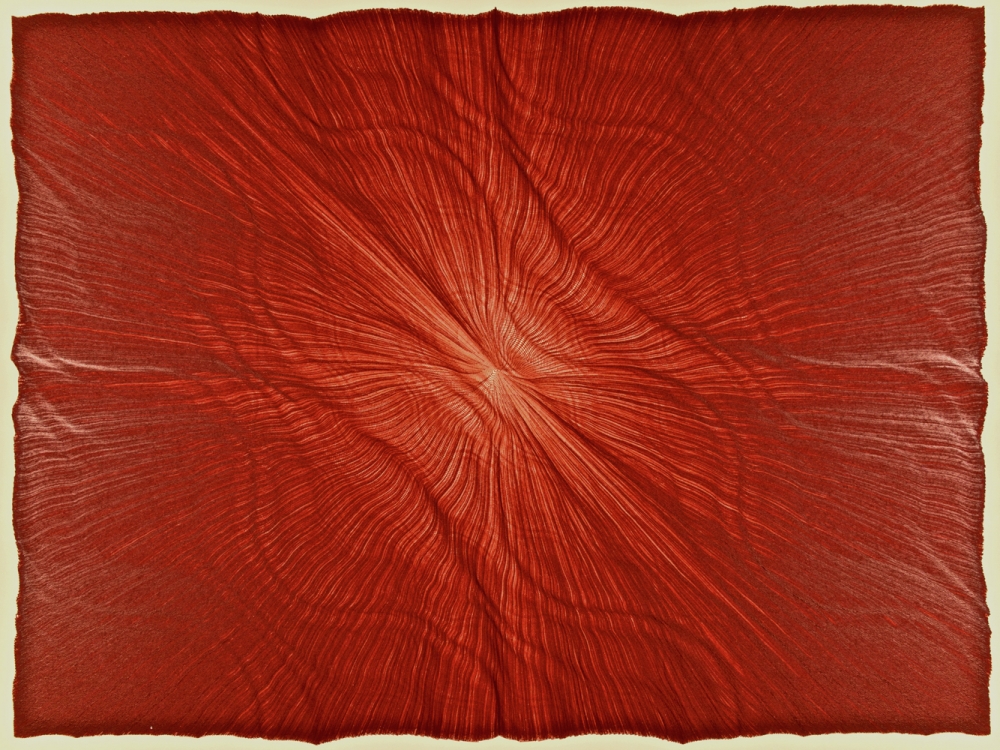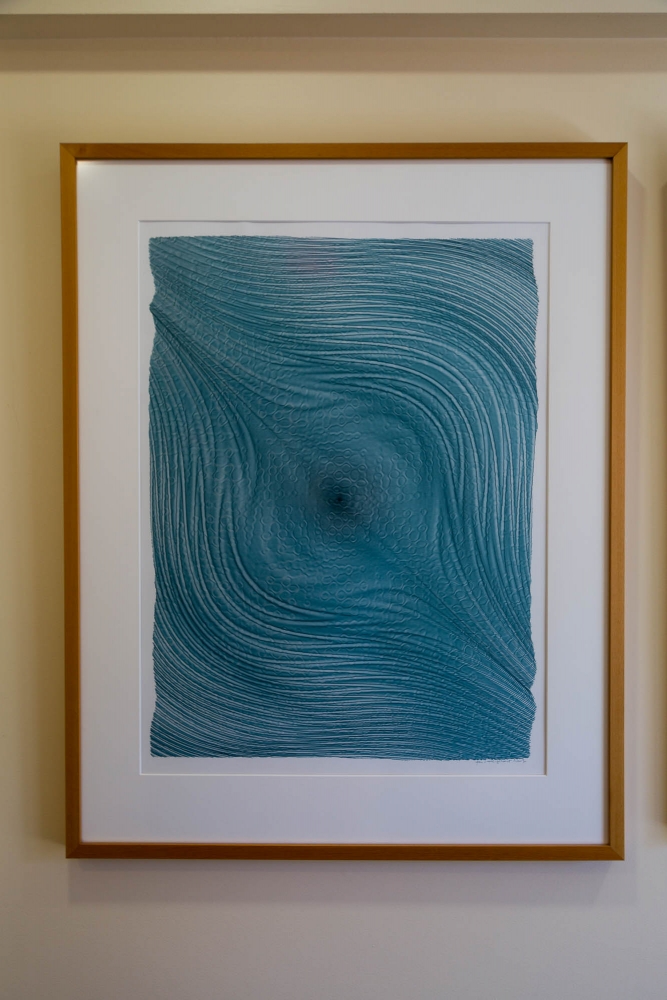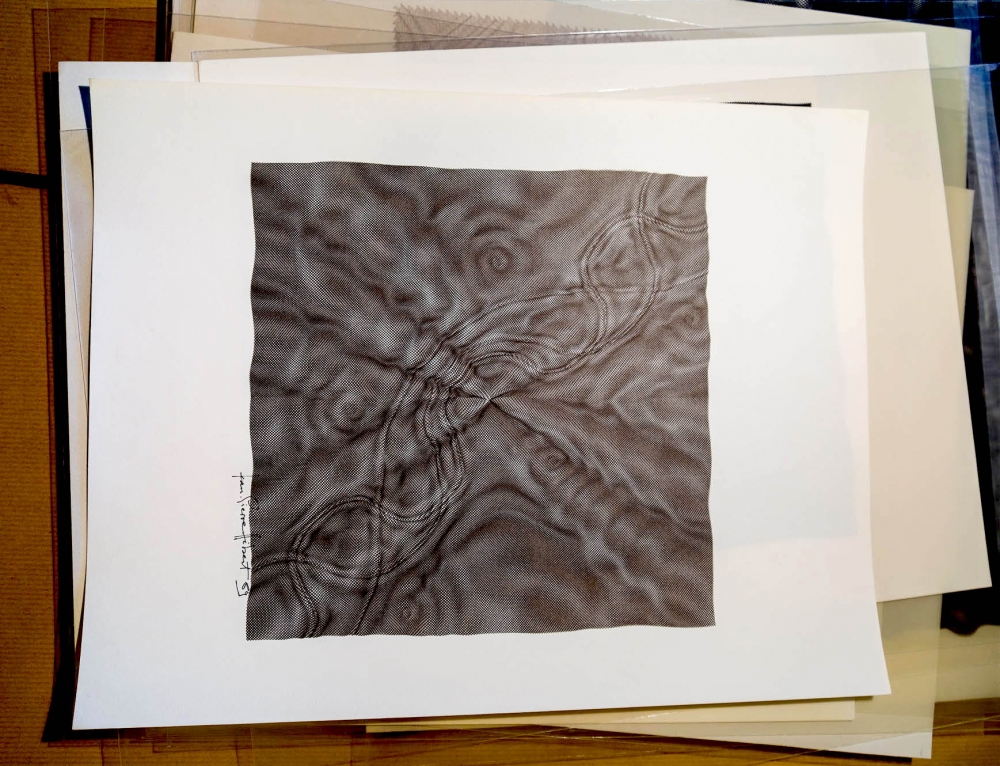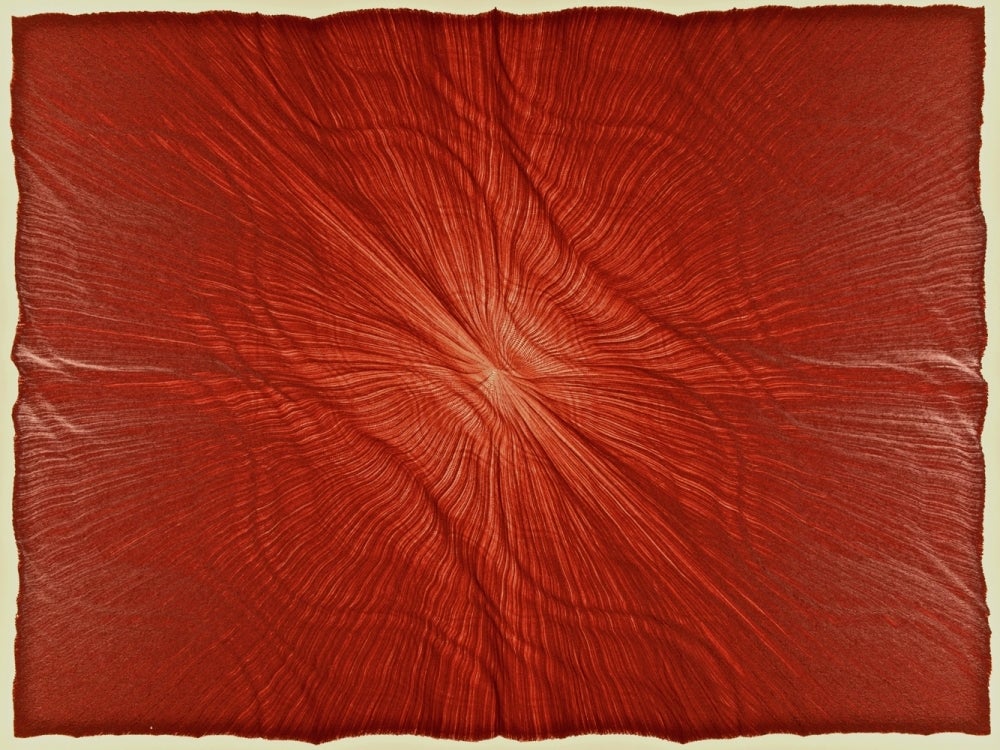
An Artistic Dimension
An air of subdued curiosity permeates Kohn Hall, the building that hosts the Kavli Institute for Theoretical Physics (KITP), where researchers from around the world seek to decipher the universe’s mysteries.
Adding to this rarified atmosphere are the many works of art adorning the building’s interior. Their abstract designs and shapes hint at an underlying pattern known solely to the artist himself. These intriguing works are the product of a collaboration between KITP and artist Jean-Pierre Hebert, who has served as the institute’s artist in residence for over 15 years.
“I was introduced to Jean-Pierre, and I fell in love with his work,” said David Gross, a Nobel laureate in physics who was the director of the institute at the time. “With his mind, his imagination, his creativity and the things he was trying out.”
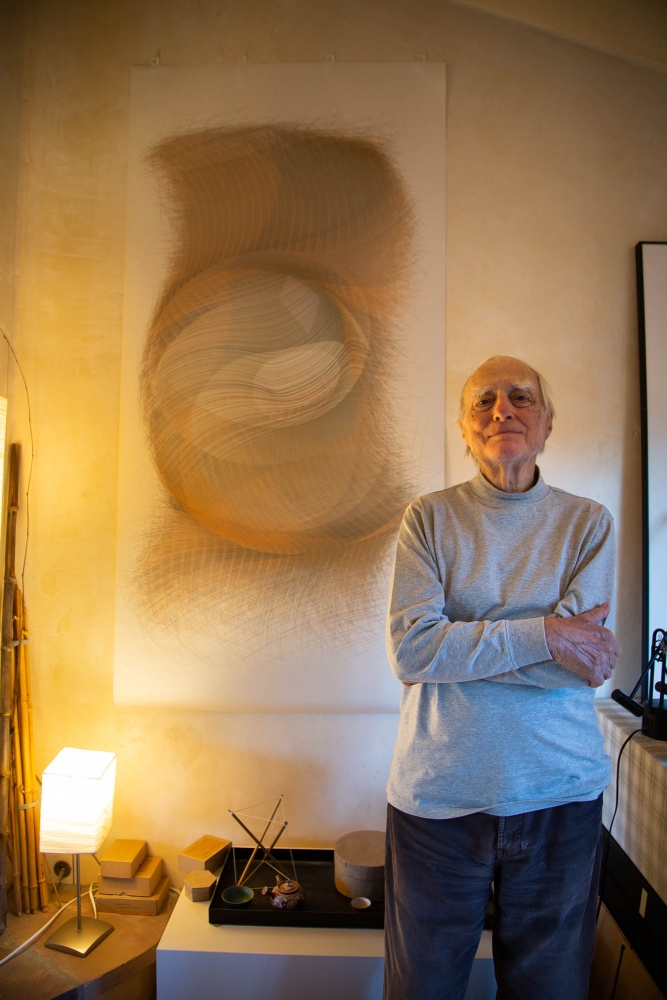
Jean-Pierre Hebert stands in his parlor next to one of his plotted art pieces.
Photo Credit: HARRISON TASOFF
Artistic passion, computational mind
The journey that led Hebert to that auspicious meeting in 2003 began in his childhood home of Vence, France, a small town set in the coastal foothills of the Maritime Alps. The region was a hub of the modern art movement, counting among its residents such luminaries as Marc Chagall, Henri Matisse and Pablo Picasso.
And Hebert was fortunate enough to have a close friend who owned one of the fine art galleries in town. The space showcased pieces from titans of the early 19th century as well as work from artists who were not classically trained. “I had open access to the gallery, to the reserve,” Hebert recalled. “I could go there whenever I wanted. I could touch everything.”
In college, he developed an interest in computers and landed a summer internship at IBM’s Paris office, located in the city’s famous Place Vendôme. The company hosted the first IBM mainframe in all of Europe, according to Hebert.
The internship proved a formative experience, and soon Hebert was joining the French Army’s Center for Operational Research after being conscripted into the military. After his service was over, he became a software consultant.
Algorithmic artistry
Hebert pursued his artistic passions throughout his time as a computer scientist. However, his penchant for algorithmic art arrived later, at the convergence of artistic inspiration and technological innovation.
One day, as he perused an IBM brochure, he came across the work of Anni Albers, an artist, printmaker and weaver. “She was making art from geometry,” he said, “and I decided to explore the process.”
And advances in computing now made this a possibility. Until that point, Hebert had worked on mainframes, and couldn’t afford to use computer time for artwork. But, by 1974, Hewlett-Packard had introduced smaller computers ideal for this pursuit. Hebert bought one and set to work.
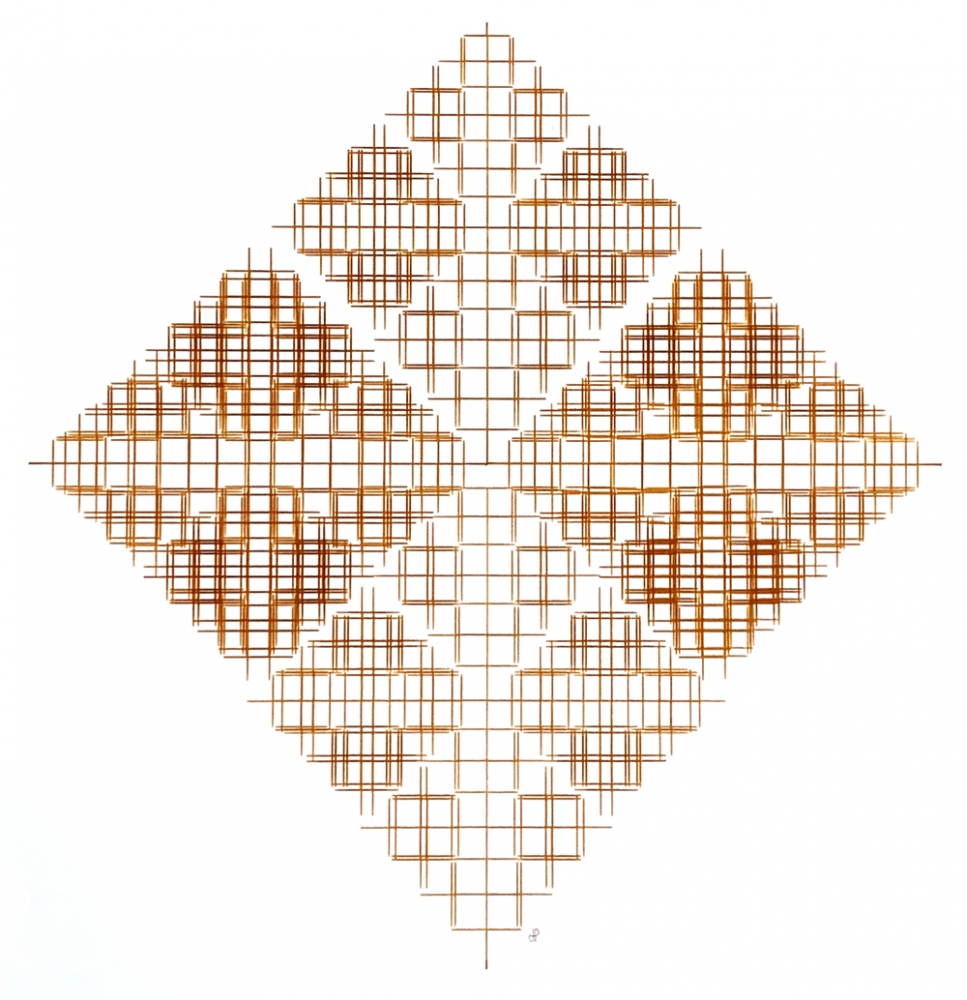
Hebert produced “Doubles Symétries,” one of his earlier pieces, sometime between 1977 and 1979 using a pen plotter.
Photo Credit: JEAN-PIERRE HEBERT
And advances in computing now made this a possibility. Until that point, Hebert had worked on mainframes, and couldn’t afford to use computer time for artwork. But, by 1974, Hewlett-Packard had introduced smaller computers ideal for this pursuit. Hebert bought one and set to work.
Many of his first pieces were grids and fractals, as the computer software allowed him to create precise patterns that would be difficult to achieve by hand. “But symmetry is boring,” Hebert remarked.
For the better part of two decades, Hebert essentially worked blind. Computer monitors weren’t good enough to render his drawings, so he didn’t know precisely how they’d turn out until he plotted them. Even after decent monitors became available in the late 1980s, the displays were mostly for code. They couldn’t capture the nuances present in the finished work for quite some time.
Around this time Hebert and his wife first visited Santa Barbara on business. The couple fell in love with the sunny, beach-side city and moved here from Paris in 1985.
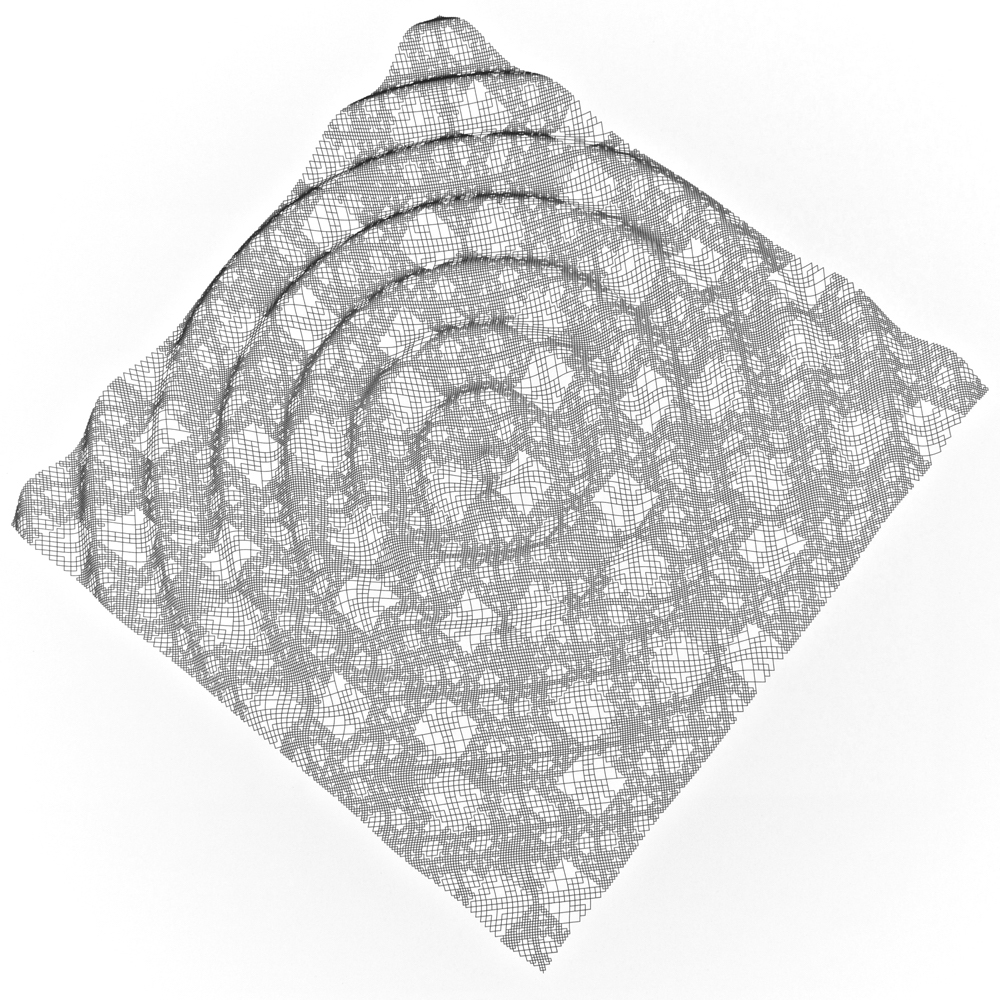
"First Wave," created in 1988, is a single uninterrupted line.
Photo Credit: JEAN-PIERRE HEBERT
Inspiration struck one day while Hebert was walking along the harbor later that year in Santa Barbara. He noticed the reflections of ships in the water. The rippling of the water transformed the stiff, orderly masts into dynamic patterns that flowed upon its surface.
“If the line is alive, the drawing will be beautiful,” Hebert said, referencing artist and poet Jean Cocteau. From then on, all of his pieces were dynamic and lively.
By 1989, Hebert had mostly left the consulting industry to pursue his art full-time. That year he held his first public art show in the very gallery his friend owned back in Vence. Later that same year, he exhibited at the SIGGRAPH conference in Boston, Massachusetts. The organizers loved his artwork, and he became a reoccurring artist at the group’s annual conferences. In 2012, ACM SIGGRAPH conferred Hebert with the Distinguished Artist Award for Lifetime Achievement in Digital Art.
A fortuitous meeting
A confluence of events brought Hebert and David Gross together in 2003 to begin what would become a fruitful partnership. Hebert, now a full-time artist, was holding a show in the former Monlleo gallery in Santa Barbara. KITP had just finished the west wing expansion of Kohn Hall, and Gross had rediscovered funds set aside to provision the building with artwork and décor.
Gross entrusted two local artists, Marcia Burtt and Beth Westen, to seek out promising work for the institute, and they approached Hebert at his show.
“I liked him, and I liked his art,” Gross recalled of his first meeting with Hebert. “I was really impressed with his story — how he came from programming with an interest in art to become a full-time artist — and with the complexity and beauty of his drawings.”
The institute purchased several of Hebert’s drawings to display in Kohn Hall, and Burtt suggested that Gross invite Hebert to join KITP as the artist in residence.
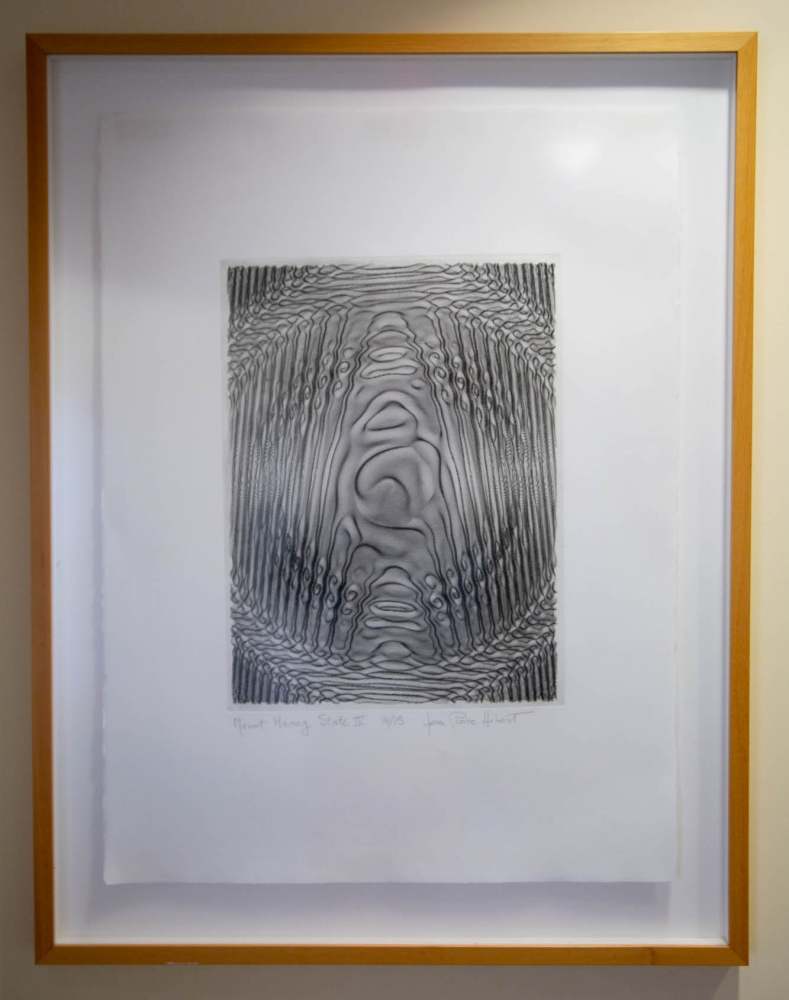
One of Hebert’s algorithmic line drawings on display in Kohn Hall.
Photo Credit: HARRISON TASOFF
Artist in residence
Dozens of Hebert’s pieces adorn the corridors of Kohn Hall, but his influence on KITP extends beyond merely what is visible. Hebert has organized workshops for the visiting fellows as well as exhibitions featuring his work and that of other artists working with mathematics and computers. “He just adds a dimension to KITP that doesn’t exist most places,” said Gross.
Hebert’s most iconic contribution to KITP is likely Ulysses — otherwise known as the sand machine — a concept he had been working on since 1998. The installation consists of a mahogany base, constructed by local furniture builder Victor DiNovi, and a hidden programmable device conceived by Hebert and designed and built by UC Santa Barbara engineer David Bothman.

Ulysses, also known as the sand machine.
Photo Credit: HARRISON TASOFF
Ulysses features a steel ball that travels across a table of sand leaving mesmerizing patterns in its trail. Each new pattern overwrites the last as the ball continues on its Zen-like journey indefinitely. Though it travels, it has no destination; and while it covers much distance, it never leaves the confines of its table.
“I just loved it,” Gross recalled. “It’s beautiful, extremely clever, and extremely original. You never grow tired of watching it.”
Hebert has also drawn inspiration from his relationship with the institute and the scientists therein. “It has been quite important for me, and for the development of my work, to be artist in residence at KITP,” he said. “It has been subtle, but it has been permanent.”
Hebert has attended a number of programs, conferences, and talks that KITP hosts. He fondly recalls one about granular materials and aggregates, which gave him an opportunity to talk to physicists about sand movement, like that in Ulysses.
“The conversations with the physicists influenced me, certainly, there is no doubt,” he said. “Each of these contacts was provoking thoughts, and this resulted in new work being created.”
.jpg)
Somewhat atypical of Hebert’s work, “Stringlets and Zigzags” (2018) is composed of colored shapes and squiggles, techniques that became available when he switched from plotters to inkjet printing in 2003.
Photo Credit: JEAN-PIERRE HEBERT
The Heberts’ relationship with UC Santa Barbara extends beyond Jean-Pierre’s position at KITP. All of their children earned their degrees at the university. Their eldest, François, earned a bachelor’s degree in physics from the College of Creative Studies and continued on to receive his doctorate at Cornell. He currently researches black holes as a Caltech postdoc working with the LIGO group.
Their daughter Marie studied violin at the UCSB, and is now a professional violinist, both teaching and performing. Daughters Anne and Claire Alice followed in their brother’s footsteps, also earning physics degrees at the College of Creative Studies. They are now pursuing their doctorates at Harvard and Stanford.
Of all of his accomplishments, Hebert is most proud of his initial genius in choosing to explore a new type of art. “I’ve done this drawing and that drawing, but they are all drawings, not ideas,” he said. “It was the idea of using the computational power of a computer to make a drawing that started everything.”
And his relationship with KITP seems to have left its mark. “It’s difficult to quantify,” he said, “but I think looking at the portfolio shows very loudly how this happened.”
